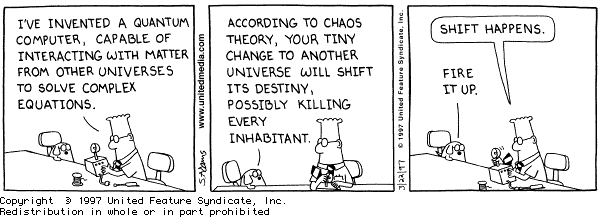

Connections Through Time, Issue 22:
January - March 2004
![]()
|
The basic idea would be to code information in a multitude of entangled photons resulting in a quantum computer offering enhanced data protection and allowing calculations in 10 seconds that now take ten years! But Professor Gisin warns that a great deal of research remains to be done before quantum computers become a reality. |

|
| from The Quantum Computer |
Continued research into quantum mechanics (QM) with a view to possible practical applications has led to a new field - quantum information technology. This technology could revolutionize the way we communicate and process information.
The important new observation is that information depends on the physical laws used to store and processes the information, e.g., information stored using classical physics concepts has a very different character than information stored using QM physics. Although modern computers rely on QM to operate, the information itself is still encoded classically. The new approach is to treat information as a quantum concept and to ask what happens when both the transmission and processing of information are governed by quantum laws?
The elementary quantity of information is the bit, which can take on one of two values - usually "0" and "1". Therefore, any physical realization of a bit needs a system with two well defined states, for example a switch where off represents "0" and on represents "1". A bit can also be represented by, for example, a certain voltage level in a logical circuit, a pit in a compact disc, a pulse of light in a glass fiber or the magnetization on a magnetic tape.
The really novel feature of quantum information technology is that a quantum system can be in a superposition of different states. In a sense, the quantum bit can be in both the "0" state and the "1" state at the same time. This new feature has no parallel in classical information theory and in 1995 Ben Schuhmacher of Kenyon College in the US coined the word "qubit" to describe a quantum bit.
A qubit can exist not only in a state corresponding to the logical state 0 or 1 as in a classical bit, but also in states corresponding to a blend or superposition of these classical states. In other words, a qubit can exist as a zero, a one, or simultaneously as both 0 and 1, with a numerical coefficient representing the probability for each state. In discussing quantum computers, Jacob West said, "This may seem counterintuitive because everyday phenomenon are governed by classical physics, not quantum mechanics -- which takes over at the atomic level."
In a Fundamentals of Quantum Information article QM entanglement adds to the counterintuitive nature of the approach: "The quantum information is encoded in such a way that none of the two qubits carries any well defined information on its own: all of the information is encoded in their joint properties. Such entanglement is one of the really counterintuitive features of quantum mechanics and leads to most of the paradoxes and other mysteries of quantum mechanics (see Bell's inequality and quantum non-locality)."
Okay, so Quantum Computers do the calculations differently...what's the big deal? The big deal is that classical computers require exponentially more time or memory to process increasing amounts of information compared to the power of quantum computers. New and increasingly complex applications are inevitable, and these will require ever increasing amounts of information processing. This means, quite simply, that classical computers will eventually need to be replaced by the much more powerful quantum computers.
After realizing the information processing advantages for quantum computers, the hunt was on to find an application. Peter Shor, a research and computer scientist at AT&T's Bell Laboratories in New Jersey, provided such an application by devising the first quantum computer algorithm. Shor's algorithm uses the power of quantum superposition to rapidly factor very large numbers (on the order ~10200 digits and greater) in a matter of seconds. This application is important to the field of encryption where it is now assumed that it is impossible to factor very large composite numbers into their primes. A computer which can do this easily is naturally of great interest to numerous government agencies and anyone interested in electronic and financial privacy.
Encryption, however, is only one application of a quantum computer. In
addition, Shor has put together a toolbox of mathematical operations that can
only be performed on a quantum computer, many of which he used in his
factorization algorithm. Also, a quantum
computer could function as a kind of simulator for quantum physics, potentially
opening the doors to many discoveries in the field.
The following is one perspective on the future outlook, from The Quantum Computer article:
"At present, quantum computers and quantum information technology remains in its pioneering stage. At this very moment obstacles are being surmounted that will provide the knowledge needed to thrust quantum computers up to their rightful position as the fastest computational machines in existence. Error correction has made promising progress to date, nearing a point now where we may have the tools required to build a computer robust enough to adequately withstand the effects of decoherence. Quantum hardware, on the other hand, remains an emerging field, but the work done thus far suggests that it will only be a matter time before we have devices large enough to test Shor's and other quantum algorithms. Thereby, quantum computers will emerge as the superior computational devices at the very least, and perhaps one day make today's modern computer obsolete. Quantum computation has its origins in highly specialized fields of theoretical physics, but its future undoubtedly lies in the profound effect it will have on the lives of all mankind."
Pat, Jim and Mary discuss quantum computers and life, during a relaxing dinner, in the next section.
References
A short introduction to quantum computation
Centre for Quantum Computation
Fundamentals of quantum information
Go to another section of this
issue:
Physics: